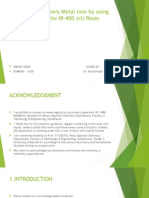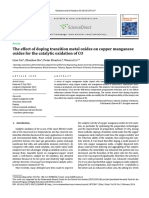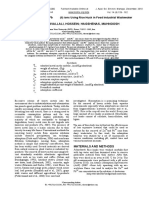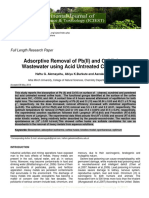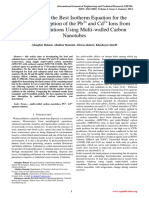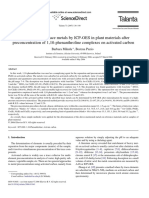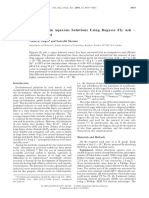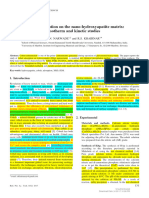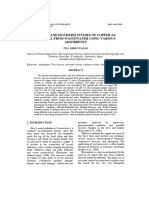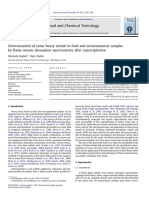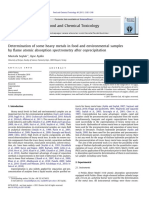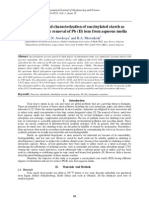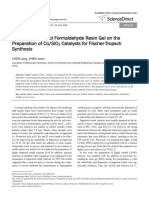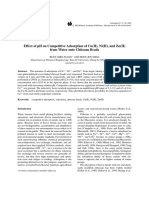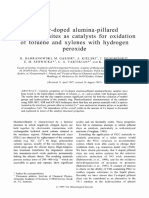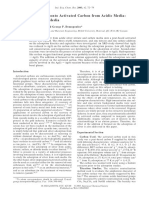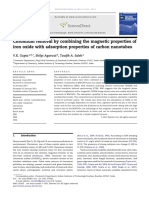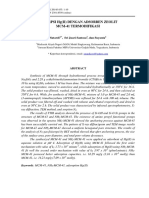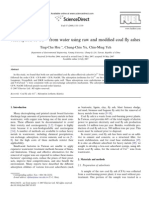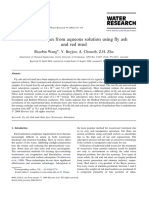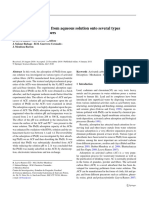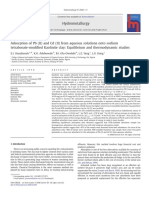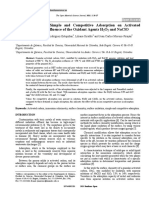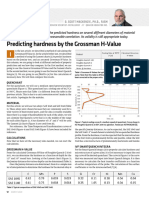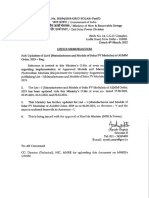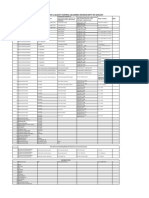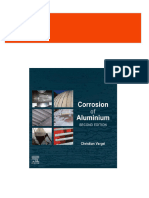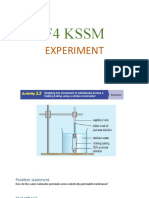2019 XANTHATED COAL AS A LEAD CATION EXCHANGER Tche Quim
2019 XANTHATED COAL AS A LEAD CATION EXCHANGER Tche Quim
Uploaded by
Roberto FernandezCopyright:
Available Formats
2019 XANTHATED COAL AS A LEAD CATION EXCHANGER Tche Quim
2019 XANTHATED COAL AS A LEAD CATION EXCHANGER Tche Quim
Uploaded by
Roberto FernandezCopyright
Available Formats
Share this document
Did you find this document useful?
Is this content inappropriate?
Copyright:
Available Formats
2019 XANTHATED COAL AS A LEAD CATION EXCHANGER Tche Quim
2019 XANTHATED COAL AS A LEAD CATION EXCHANGER Tche Quim
Uploaded by
Roberto FernandezCopyright:
Available Formats
XANTHATED COAL AS A LEAD CATION EXCHANGER FOR
ENVIRONMENTAL REMEDIATION
VÁSQUEZ-OSORIO, Yelitza 1, ESPINOSA-FUENTES, Eduardo Antonio 2, COLPAS-
CASTILLO, Fredy 1, MEZA-FUENTES, Edgardo 1 and FERNANDEZ-MAESTRE, Roberto 1*
1 Programa de Quimica, Campus de San Pablo, Universidad de Cartagena, Zaragocilla, Cartagena, Colombia
2 Corporación Universitaria de la Costa (CUC), Barranquilla, Colombia,
*Corresponding autor rfernandezm@unicartagena.edu.co tel 575-6469578 fax 575-6698180
Received 12 June 2000; received in revised form 30 November 2000; accepted 14 December 2000
RESUMO
Palavras-chave:
ABSTRACT
High concentrations of heavy metals in industrial effluents has led to contamination of natural water
bodies. To remove these heavy metals, we prepared a cation exchanger from coal (OC) modified by treatment
with CS2 and NaOH, to obtain xanthated coal (XC). Lead removal was best at pH 5 with adsorption of 74% and
98% for OC and XC. The adsorption reached equilibrium at 120 min (pseudo-second order kinetics). Isotherms
showed OC best suited to Langmuir isotherm but, once xanthated, to Freundlich. Coal xanthation has been rarely
reported and produces new carbon materials through the modification of low rank coal.
Keywords: coal, adsorption, xanthates, lead, cation exchangers
INTRODUCTION Blancas et al. 2013; Chakraborty and Tare 2006).
Xanthates are formed by reacting an organic
Pollution of water bodies with lead and substrate containing hydroxyl groups with carbon
other heavy metals has endangered the health of disulfide under basic conditions (Liang et al. 2009):
humans and animals because, as they do not
− +
degrade in the environment, metals accumulate in 𝐶𝑜𝑎𝑙 − 𝑂𝐻 + 𝐶𝑆2 + 𝑁𝑎𝑂𝐻 → 𝐶𝑜𝑎𝑙 − 𝑂𝐶𝑆2 + 𝑁𝑎
living tissues causing serious diseases and
disorders due to their toxic and carcinogenic The chemical composition of mineral coal
effects (Ngah and Hanafiah 2008). To remove makes it an ideal substrate for the synthesis of
these heavy metals from wastewater various xanthates for its high content of hydroxyl functional
conventional methods have been used; however, groups. Retention of heavy metals from the
these methods are not economical or effective incorporation of xanthate groups in carbonaceous
when the concentration of metals is low (Torres materials has been investigated by several
Blancas et al. 2013). Coal has some ion exchange researchers (Chammui et al. 2014). Haenel (1992)
capacity in its natural structure (Féris et al. 2000) used xanthation to increase the content of
that can be increased by chemical modification of functional groups for complexation of metals in
its surface (Orjuela et al. 2000; Vassileva and coal through the free electrons in carbon disulfide,
Detcheva 2011). These modifications can be CS2.
carried out with sulfur groups, characterized by a The experimental data is validated with
high affinity for heavy metals. Among sulfur different models of adsorption isotherms.
groups, xanthates show a strong binding to heavy Although, such adsorption models were initially
metals and have been used to increase the developed for gas adsorption on solids they can
adsorption capacity of different materials (Torres be applied to chemisorption on a surface. The
PERIÓDICO TCHÊ QUÍMICA • www.periodico.tchequimica.com • Vol. 6 N. 12.
• ISSN 1806-0374 (impresso) • ISSN 1806-9827 (CD-ROM) • ISSN 2179-0302 (meio eletrônico)
© 2010. Porto Alegre, RS. Brasil 1
adsorption models of Freundlich and Langmuir are
mainly used in the processes where the The effect of pH on the adsorption of Pb2+
phenomenon of chemisorption occurs which is was examined through a mixture of 50 mg of XC
typical of ion exchange phenomena using and OC with 10 ml of 100 ppm Pb2+ at 25°C.
exchange resins. These isotherms are mainly Analyses were performed at pH values of 3 to 5
used for the study of catalysis phenomena at the adjusted by adding 0.1 mol L-1 HNO3 solution and
industrial level and are those that are mainly used 0.1 mol L-1 NaOH. After 3 h stirring, the solutions
in the literature for the characterization of ion were filtered and the filtrate concentration was
exchange phenomena of metals in exchange determined.
resins (Silgado, Marrugo, and Puello 2014; For the kinetic study of Pb2+, 500 mg of
Šćiban, Klašnja, and Škrbić 2006). adsorbent were mixed with 100 ml of 100 ppm of
We investigated the preparation of an Pb2+ at pH 5 for 2.2 h and 25 ° C. Samples were
adsorbent from the incorporation of xanthate withdrawn at different time intervals to determine
groups on the carbon surface and the evaluation the concentration of lead. Pb2+ adsorption
of its Pb2+ adsorption from aqueous solutions by experiments were carried out mixing 50 mg of the
kinetic studies and pH for optimum adsorption. adsorbent with 10 mL of Pb2+ at 25, 50, 100, 200
or 400 ppm, pH 5, 2 h and 25 °C. The amount of
2. Material and methods adsorbed metal was determined using:
2.1. Instrumental C0 V0 - Ce V0
qe = m
(Eq. 1)
Metal concentrations were determined by
Where C0 is the initial concentration of Pb2+ in mg
flame atomic absorption spectrometry (ICE 3000,
L-1, V0 the initial volume of the solution in L, Ce
Thermo Scientific, Zeeman correction). Other
the Pb2+ concentration at equilibrium in mg L-1
parameters were measuring time: 4.0 s and
and m the adsorbent mass in grams.
number of replicate analyses, 3. Solutions were
prepared with a sodium acetate/acetic acid buffer
2.4. Specific Surface Area
and the ionic strength was adjusted with NaCl.
Infrared spectra of the adsorbents were obtained
To obtain nitrogen adsorption isotherms by
by mixing one mg of coal with 100 mg of KBr,
the BET method, we used a Gemini II 2375
compressing to obtain a pellet that was analyzed
apparatus (Micromeritics, Norcross, GA, U.S.A.).
on an FTIR (SHIMADZU-8400) in the 4000-400
The analysis had the following steps: 0.200 g of
cm-1 range.
sample in a tube, was heated at 200°C, subjected
to vacuum up to a pressure of 2 μm Hg, and
2.2. Coal xanthation
weighted. we later graphed 1/[Vads (po/p-1)] versus
p°/p in the 0.01-0.1 pressure relative range to
A subbituminous coal sample, from La measure specific surface area. The I-point
Loma Cesar mine (Colombia), was swelled for 7
(inflection point) was determined using V(1-p/p°)
days with acetone, washed with distilled water and
versus po/p, or V(1-p/p°)/(p/po) versus V(1-p/p°)
dried at 70 °C for 24 h. Subsequently, it was milled
(Ladavos et al. 2012). The linear range of p versus
in a ball mill, sieved to 0.225 mm, washed with 0.1
p/Vads graph was used to calculate the Langmuir
mol L-1 HCl and distilled water to neutral pH, and area. The textural characterization of the solid
dried at 70°C for 24 h to remove possible
obtained with the adsorption isotherms is
contaminants and colored substances. The
important because it gives us information about
product obtained was named OC. Later, 25 grams
the pore size distribution. This is important in
of coal were taken, 424 mL of a 4 mol L-1 NaOH
determining the type of adsorbate that can diffuse
solution was added using a 0.06 carbon/NaOH into the pores and be chemically exchanged on the
w/w ratio stirring for 3 hours, and later 102 mL of
surface of the adsorbent. For this reason, it is
CS2 with a 4.08 CS2/coal w/w ratio and stirring for
important to determine the selectivity that some
4 hours. The mixture was allowed to stand for 16
materials show towards a certain type of for certain
hours, filtered, washed several times with
types of analytes.
deionized water and dried at 70°C (Chakraborty
and Tare 2006). This product was designated XC.
RESULTS AND DISCUSSION
2.3. Adsorption Experiments
PERIÓDICO TCHÊ QUÍMICA • www.periodico.tchequimica.com • Vol. 6 N. 12.
• ISSN 1806-0374 (impresso) • ISSN 1806-9827 (CD-ROM) • ISSN 2179-0302 (meio eletrônico)
© 2010. Porto Alegre, RS. Brasil 2
3.1. Effect of pH
One important property of adsorbents is the speed
The effect of pH on the adsorption of Pb2+ in OC with which the adsorbate is adsorbed and reaches
and XC is shown in Figure 1, which shows that pH equilibrium. The mathematical model that
affected the adsorption of Pb2+ in aqueous describes the amount of Pb2+ adsorbed at a zero
solution. At low pH, there is a poor adsorption of time and at a specific time, is given by:
Pb2+ as a result of the strong electrostatic
repulsion of H+ ions on the carbon surface with the mg Pb2+ [(CV)n-1 - (CV)n ] mg Pb2+
metal ions, which prevent these to interact with the ( ) = + ( )
g n
g g n-1
adsorbent (Chakraborty and Tare 2006). By
increasing pH, the repulsion becomes weak,
favoring the diffusion of Pb2+ ions to the adsorbent Where C is the remaining concentration of Pb2+ at
surface, which increases adsorption (Jiang, Pang, time t in mg L-1 (calculated with Equation 2), V the
and Liao 2009). volume of the remaining solution at time t in liters,
and n the number of data taken in time t. The graph
of Pb2+ adsorbed as a function of time, allows
identifying the time the equilibrium is reached and
the corresponding adsorption capacity, qe (Acar
and Eren 2006). To assess the rate of Pb2+
adsorption on OC and XC, two kinetic models
were considered. The model of pseudo-first order
was proposed by Lagergren (Tseng, Wu, and
Juang 2010; Lagergren 1898):
k1
log(qe - qt ) = log qe - t
2.303
Where qe and qt are the adsorption capacities (mg
Figure 1. Effect of the exchange solution pH on g-1) at equilibrium and time t (s), respectively, and
Pb2+ adsorption on OC (□) and XC (◊). Adsorbent k1 is the rate constant model (min-1). k1 values are
dose: 50 mg/10 mL, concentration: 100 ppm of obtained from the intercept and slope of the graph
Pb2+, contact time: 3 h. The optimum adsorption of log (qe -qt) vs. t. The kinetic model of pseudo-
pH was 5. second order is given by the equation:
t 1 1
= 2
+ t
Figure 1 shows the maximum adsorption of Pb2+ qt k2 qe qe
on OC and XC at pH 5, with adsorptions of 74% Where qe and qt were defined in the model of
and 99% from solutions of 100 ppm Pb2+ and pseudo-first order, and k2 is the rate constant
doses of 50 mg/10 ml of adsorbent, respectively. model of pseudo-second-order (g mg-1 min-1)
The main advantage of XC over OC is that the (Torres Blancas et al. 2013). k2 and qe values are
adsorption of Pb2+ is higher at all pH values. This obtained from the intercept and slope of the graph
is consistent with reports by Torres-Blancas et al. of t/qt vs. t (Silgado, Marrugo, and Puello 2014).
(2013) who evaluated the adsorption of lead in This model also assumes that the initial rate of
pepper peel and xanthated pepper peel; they adsorption, h0, (mg g-1 min-1) is proportional to the
observed that at low pH, the adsorption on pepper square of the number of remaining free surface
peel was poor as a result of the strong electrostatic sites, defined by:
repulsion, while the adsorption of lead was greater
for xanthated pepper peel in all pH ranges. Similar h0 = k 2 q2e
results have been reported (Orjuela et al. 2000;
Liang, Guo, and Tian 2011; Taty-Costodes et al. Where qe and k2 are the adsorption capacity (mg
2003). g-1) and the pseudo-second order model rate
constant (g mg-1 min-1), respectively. The results
3.2. Adsorption kinetics for each model are described in Table 1.
PERIÓDICO TCHÊ QUÍMICA • www.periodico.tchequimica.com • Vol. 6 N. 12.
• ISSN 1806-0374 (impresso) • ISSN 1806-9827 (CD-ROM) • ISSN 2179-0302 (meio eletrônico)
© 2010. Porto Alegre, RS. Brasil 3
Table 1. Kinetic parameters for OC and XC. Pb2+ concentration: 100 ppm, adsorbent dose: 500 mg/100
mL, pH: 5, contact time: 140 min. Adsorbents followed a pseudo second-order kinetics.
Kinetic Model
Pseudo first order Pseudo second order
qe
Adsorbent qe qe k2
(exp) k1
model R2 model (g mg-1 R2 h0 (mg g-1)
min-1
(mg g-1) (mg g-1) min-1)
OC 16.8 16.0 0.031 0.919 17.3 0.018 1.000 5.98
XC 19.8 19.7 0.056 0.901 19.6 0.036 1.000 14.2
qe (exp): experimental qe
From the data, it follows that, for the pseudo-first factor RL given by:
order kinetic model, the theoretical values of qe for 1
𝑅𝐿 =
OC and XC differ from the experimental q e, as 1 + bCo
evidenced by the regression coefficients of 0.919
and 0.901 for OC and XC, respectively, but they Where, b is the Langmuir constant and Co the
agree on the model of pseudo-second order with initial concentration of adsorbate in the solution.
a regression coefficient of 1.00 for both OC and RL indicates the shape of the isotherm and if the
XC. Therefore, the mechanism of adsorption of adsorption is favorable or not, according to: if RL>
lead ions on OC and XC is represented by the 1 it is unfavorable, RL = 1 linear, 0 <RL <1
pseudo-second order kinetic model, and this favorable, and RL = 0 the adsorption is irreversible
agrees with the literature (Torres Blancas et al. (Memon et al. 2007).
2013; Liang et al. 2009; Šćiban, Klašnja, and
Škrbić 2006). This indicates that chemical Unlike the Langmuir isotherm, that assumes a
adsorption was the mechanism of speed control. homogeneous surface, the Freundlich isotherm
As for the initial velocity h0, this was higher for XC considers a heterogeneous surface and is used at
than for OC, confirming that xanthation increased low pressures:
the adsorbent affinity towards metals. 1
Log qe = log KF + Log Ce
n
3.3. Adsorption isotherms
Where qe is the amount of material adsorbed by a
Adsorption isotherms are mathematical models specific amount of adsorbent (mg g-1), Ce the
used to estimate the maximum amount of equilibrium concentration (mg L-1) in the liquid
contaminant that an adsorbent can remove from phase, KF the Freundlich constant (mg1/n L1/n g- 1)
aqueous solution. The adsorption isotherms were and n the heterogeneity factor which depends on
evaluated using the Langmuir and Freundlich the substance (Liang et al. 2009). Figure 2 shows
models. The Langmuir isotherm is given by: the Langmuir and Freundlich isotherms for Pb2+
adsorption and Figure 3 the separation factors for
Ce 1 Ce OC and XC.
= + The isotherms in Figure 2 show that the
qe qm b qm
adsorption capacity in the equilibrium, Ce,
Where qe is the amount of material increases as a function of concentration in
absorbed by a specific amount of adsorbent (mg solution, qe, while Figure 3 confirms that the
g-1), Ce the equilibrium concentration (mg L-1), qm adsorption of Pb2+ on OC and XC was favorable
the amount of metal or contaminant necessary to because the RL values for all metal concentrations
form a monolayer on the adsorbent surface (mg g- were in the range 0 - 1. According to Kumar, Rao,
1
) and expresses its maximum adsorption and Kaul (2000), this means that adsorption is
capacity, and b the Langmuir constant (L mg-1) more favorable at high concentrations. Table 2
(Silgado, Marrugo, and Puello 2014; Šćiban, shows the values of the isotherm parameters for
Klašnja, and Škrbić 2006). The characteristics of OC and XC, determined by least squares.
the Langmuir isotherm can be expressed in terms
of a constant dimension known as the separation
PERIÓDICO TCHÊ QUÍMICA • www.periodico.tchequimica.com • Vol. 6 N. 12.
• ISSN 1806-0374 (impresso) • ISSN 1806-9827 (CD-ROM) • ISSN 2179-0302 (meio eletrônico)
© 2010. Porto Alegre, RS. Brasil 4
Figure 2. Langmuir and Freundlich isotherms for Pb2+ adsorption on OC and XC. Adsorbent dose: 50
mg/10 mL, metal concentration: 100 ppm of Pb2+, contact time: 120 min. pH: 5. OC adsorption fits the
Langmuir isotherm and XC a Freundlich type; qe is the adsorption capacity of Pb2+ and Ce the
equilibrium concentration of Pb2+.
Figure 3. Separation Factors (RL) in the adsorption of Pb2+ on OC and XC. Adsorption was favorable
because 0 <RL> 1. Ce is the initial concentration of Pb2+.
Table 2. Langmuir and Freundlich isotherm parameters for Pb2+ adsorption on OC and XC.
Adsorption isotherms
Langmuir Freundlich
Adsorbent
qm, b
R2 RL KF, L g-1 n R2
mg g-1 L mg-1
OC 10.4 0.416 0.97 0.035 1.042 0.39 0.914
XC 60.1 0.025 0.53 0.32 96.39 0.68 0.981
qm: amount of metal or contaminant necessary to form a monolayer on the adsorbent surface (mg g -1. b: Langmuir
constant (L mg-1). R: correlation coefficient. RL: separation factor. KF: Freundlich constant (mg1/n L1/n g- 1).
To determine which of the two isotherm models which formed a monolayer, wherein each
was best suited to Pb2+ adsorption, we evaluated adsorption site may adhere a single adsorbate
correlation coefficients that measure how well the molecule, and they have the same adsorption
experimental values were adjusted to theoretical energy. Our results also partially agree with Liang
ones (Pillai et al. 2013; Panda, Das, and Guha et al. (2009), who studied the adsorption of lead on
2008). Table 2 shows that the correlation untreated orange peel, and concluded that it
coefficients with respect to lead adsorption on OC follows a Freundlich isotherm type, but once
were 0.971 and 0.914, and for XC, 0.53 and 0.981, xanthated follows a Langmuir type. On the other
for the Langmuir and Freundlich models, hand, Torres-Blancas et al. (2013) established
respectively. This means that for OC and XC the that the adsorption of lead on xanthated and
best fits are given by the Langmuir and Freundlich untreated pepper peel follows a Freundlich
models, respectively. That is, in XC, lead isotherm type. This means that the type of
adsorption occurred due to the energy distribution isotherm depends on the nature of adsorbent
of the active sites for adsorption and the absence used. Thermodynamically, when the adsorption
of monolayers and, in OC, the Pb2+ adsorption was kinetic model is of pseudo second order, the
given on a surface of homogeneous adsorbent system seeks its lower energy state by finding its
PERIÓDICO TCHÊ QUÍMICA • www.periodico.tchequimica.com • Vol. 6 N. 12.
• ISSN 1806-0374 (impresso) • ISSN 1806-9827 (CD-ROM) • ISSN 2179-0302 (meio eletrônico)
© 2010. Porto Alegre, RS. Brasil 5
equilibrium, a typical behavior for pseudo-second associations such as alcohols and phenols (Torres
order mechanisms. This is, the activation energy Blancas et al. 2013), and at 2920 cm-1 due to CH
between the solid surface and the adsorbed lead groups stretching vibration produced by alkanes
ion reaches its maximum value when the number and -OCH3 and -CH2OH groups, in the structure of
of the interactions between them manages to coal (Liang, Guo, and Tian 2011). The peak at
generate the value of that energy. 1696 cm-1 was the result of stretching vibrations of
carbonyl groups in coal. The peaks at 1648, 1616,
3.4. Infrared spectroscopy 1560, 1542, 1510, 1456, 1431 and 1423 cm-1 were
due to stretching vibrations of C = C bonds of
The FTIR spectra of OC and XC are shown in aromatic groups in coal. The peaks at 1313, 1338,
Figure 4. In the spectrum of OC, broad, intense 1190, 1167 and 1114 cm-1 were assigned to
absorption peaks around 3442 cm-1 correspond to torsion or deformation and O-H stretching
OH stretching vibrations due to inter and intra vibrations of C-O of primary and secondary
macromolecular hydrogen bonds of molecular alcohols, and phenolic groups.
PERIÓDICO TCHÊ QUÍMICA • www.periodico.tchequimica.com • Vol. 6 N. 12.
• ISSN 1806-0374 (impresso) • ISSN 1806-9827 (CD-ROM) • ISSN 2179-0302 (meio eletrônico)
© 2010. Porto Alegre, RS. Brasil 6
Figure 4. FTIR spectra of OC (above) and XC (below)
Some changes were observed in the spectrum of This is consistent with reports by Panda, Das, and
XC with respect to OC. For example, the peaks Guha 2008), who identified xanthate groups in
due to stretching vibrations of OH, CH2 and CH3 Lathyrus Sativus peel, a legume from Asia and
groups are weaker and more elongated than in OC East Africa, by peaks appearing at 661, 1080,
because hydroxyl groups reacted with CS2. 1163 and from 1200 to 1250 cm-1; Pillai et al.
Xanthate groups in XC have been identified by the (2013) who associated sulfur groups to peaks at
appearance of new peaks at 610 and 1034 cm-1 538, 1020 and 1151 cm-1 corresponding to γC-S,
- γC=S y γ S-C-S vibrations; and Mustafa, Hamid,
PERIÓDICO TCHÊ QUÍMICA • www.periodico.tchequimica.com • Vol. 6 N. 12.
• ISSN 1806-0374 (impresso) • ISSN 1806-9827 (CD-ROM) • ISSN 2179-0302 (meio eletrônico)
© 2010. Porto Alegre, RS. Brasil 7
and Naeem (2004), who indicated that xanthate such as temperature, adsorbent dose, Pb2+
groups were found at 800-1200 cm-1. solution concentration and volume, adsorption
time, and adsorption experiment set-up such as
3.5. Comparison with other adsorbents passing the solution through a column filled with
the adsorbent or stirring a mixture lead-adsorbent
The present results were compared with data on etc. However, the adsorption capacity of our
lead adsorption from the literature (Table 3). The adsorbent was comparable to those of other
comparison of the different experiments in Table 3 experiments (Simonova et al. 2010).
is difficult because they used different conditions
Table 3. Comparison of Pb2+adsorption with data from other adsorbents in the literature.
Location Adsorption
Coal type Kinetics Model Reference
capacity
El Cerrejon, Pseudo
Subbituminous Langmuir 10.4 mg g-1 This work
Colombia second order
Xanthated El Cerrejon, Pseudo
Freundlich 60 mg g-1 a This work
Subbituminous Colombia second order
Activated Lakhra, Pseudo first Bhutto and
Langmuir 758 ± 8 mg g−1 b
Lignite Pakistan order Khan 2012
Lakhra, Pseudo first Bhutto and
Lignite Langmuir 2-3 mg g−1 b
Pakistan order Khan 2012
Alkali-activated Aleksandriisk Simonova et
First order Freundlich 54-170 mg g−1 c
Brown coal Ukraine al. 2010
Activated
Yi et al. 2016
carbon from China d First order Langmuir 162 mg g-1
coal
a
50 mg of adsorbent with 10 mL of Pb2+ at 25-400 g L-1; b 28°C; the effluent was passed through a
column of 0.9 cm I.D. with 1.49 g cm-3 packing density, with 2.0 g of adsorbent; c 20°C, Initial
concentration of lead, С0 = 0.2– 20 g L-1; d from Guoqing Water Purification Material Co. Ltd. 100 mL of
Pb(II) solution; 0°C; 20°C; 20°C; 20°C; 20°C.
014
4. Conclusions
2. Bhutto, S.; M. N. Khan; The use of
Swelled xanthated coal has a great potential as an indigenous coal reserves for the removal
efficient adsorbent. Its adsorption capacity of Pb2+ of lead (II) from the aquatic environment
was 60 mg Pb2+ g-1, following a Freundlich type by adsorption. Int. J. Environ. Stud. 2012,
isotherm. The optimal pH for adsorption was ≥ 5 69, 888.
with 99% adsorption. Kinetic analysis showed that https://doi.org/10.1080/00207233.2012.72
the adsorption equilibrium was reached in about 8316
120 minutes following a pseudo-second order
kinetics. FTIR spectra showed the incorporation of 3. Chakraborty, S.; V. Tare; Role of various
xanthate groups in the chemical structure of coal. parameters in synthesis of insoluble
The introduction of xanthate groups were agrobased xanthates for removal of copper
responsible for the high metal adsorption of the from wastewater. Biores. Technol. 2006,
modified coal. 97, 2407.
https://doi.org/10.1016/j.biortech.2005.10.
5. References 010
4. Féris, L. A.; J. A. Flores, I. A. Schneider,
1. Acar, F. N.; Z. Eren; Removal of Cu (II)
J. Rubio; Sorption of heavy metals on a
ions by activated poplar sawdust (Samsun
coal beneficiation tailing material. I:
Clone) from aqueous solutions. J. Hazard.
Characterization and mechanisms
Mat. 2006, 137, 909.
involved. Int. J. Coal Prep. Utiliz. 2000,
https://doi.org/10.1016/j.jhazmat.2006.03.
PERIÓDICO TCHÊ QUÍMICA • www.periodico.tchequimica.com • Vol. 6 N. 12.
• ISSN 1806-0374 (impresso) • ISSN 1806-9827 (CD-ROM) • ISSN 2179-0302 (meio eletrônico)
© 2010. Porto Alegre, RS. Brasil 8
21, 477. 078
https://doi.org/10.1080/073493401089456
32 12. Liang, S.; X. Guo, Q. Tian; Adsorption of
Pb2+ and Zn2+ from aqueous solutions by
5. Chammui, Y.; P. Sooksamiti, W. Naksata, sulfured orange peel. Desalination. 2011,
O.A. Arqueropanyo; Kinetic and 275, 212.
mechanism of arsenic ions removal by https://doi.org/10.1016/j.desal.2011.03.00
adsorption on leonardite char as low cost 1
adsorbent material. J. Chil. Chem. Soc.
2014, 59, 2378. 13. Memon, S. Q.; N. Memon, S. W. Shah, M.
http://dx.doi.org/10.4067/S0717- Y. Khuhawar, M. I. Bhanger; Sawdust—A
97072014000100028 green and economical sorbent for the
removal of cadmium (II) ions. J. Hazard.
6. Haenel, M. W.. Recent progress in coal Mat. 2007, 139, 116.
structure research. Fuel 1992, 71, 1211. https://doi.org/10.1016/j.jhazmat.2006.06.
https://doi.org/10.1016/0016- 013
2361(92)90046-Q
14. Mustafa, S.; A. Hamid, A. Naeem;
7. Jiang, Y.; H. Pang, B. Liao; Removal of Xanthate adsorption studies on
copper (II) ions from aqueous solution by chalcopyrite ore. Int. J. Min. Process. 2004,
modified bagasse. J. Hazard. Mat. 2009, 74, 317.
164, 1. https://doi.org/10.1016/j.minpro.2004.04.0
https://doi.org/10.1016/j.jhazmat.2008.07. 06
107
15. Ngah, W. W.; M. A. K. M. Hanafiah;
8. Kumar, A.; N. N. Rao, S. N. Kaul; Alkali- Removal of heavy metal ions from
treated straw and insoluble straw xanthate wastewater by chemically modified plant
as low cost adsorbents for heavy metal wastes as adsorbents: a review. Biores.
removal–preparation, characterization and Technol. 2008, 99, 3935.
application. Biores. Technol. 2000, 71, https://doi.org/10.1016/j.biortech.2007.06.
133. https://doi.org/10.1016/S0960- 011
8524(99)00064-4
16. Orjuela, A.; N. Civetta, J. Rivera, A.
9. Ladavos, A. K.; A. P. Katsoulidis, A. Boyacá, J. Díaz; Preparación de
Iosifidis, K. S. Triantafyllidis, T. J. intercambiadores catiónicos a partir de
Pinnavaia, P. J. Pomonis; The BET carbón. Rev. Col. Quím. 2000, 29, 53.
equation, the inflection points of N2 https://doi.org/10.15446/rev.colomb.quim
adsorption isotherms and the estimation of
specific surface area of porous 17. Panda, G. C.; S. K. Das, A. K. Guha;
solids. Micropor. Mesopor Mat. 2012, 151, Biosorption of cadmium and nickel by
126. functionalized husk of Lathyrus
https://doi.org/10.1016/j.micromeso.2011. sativus. Colloid Surface B, 2008, 62, 173.
11.005 https://doi.org/10.1016/j.colsurfb.2007.09.
034
10. Lagergren, S.; Zur theorie der
sogenannten adsorption geloster 18. Pillai, S. S.; B. Deepa, E. Abraham, N.
stoffe. Kungliga svenska Girija, P. Geetha, L. Jacob, M. Koshy;
vetenskapsakademiens. Handlingar 1898, Biosorption of Cd (II) from aqueous
24, 1. solution using xanthated nano banana
https://ci.nii.ac.jp/naid/10027970486/en cellulose: equilibrium and kinetic
studies. Ecotoxicol. Environ. Saf. 2013, 98,
11. Liang, S.; X. Guo, N. Feng, Q. Tian; 352.
Application of orange peel xanthate for the https://doi.org/10.1016/j.ecoenv.2013.09.0
adsorption of Pb2+ from aqueous 03
solutions. J. Hazard. Mat. 2009, 170, 425.
https://doi.org/10.1016/j.jhazmat.2009.04. 19. Šćiban, M.; M. Klašnja, B. Škrbić; Modified
PERIÓDICO TCHÊ QUÍMICA • www.periodico.tchequimica.com • Vol. 6 N. 12.
• ISSN 1806-0374 (impresso) • ISSN 1806-9827 (CD-ROM) • ISSN 2179-0302 (meio eletrônico)
© 2010. Porto Alegre, RS. Brasil 9
softwood sawdust as adsorbent of heavy 1160. https://doi.org/10.1186/s40064-016-
metal ions from water. J. Hazard. Mat. 2839-4
2006, 136, 266.
https://doi.org/10.1016/j.jhazmat.2005.12.
009
20. Silgado, K. J.; G. D. Marrugo, J. Puello;
Adsorption of chromium (VI) by activated
carbon produced from oil palm
endocarp. Chem. Eng. Trans. 2014, 37,
721. www.aidic.it/cet/14/37/121.pdf
21. Simonova, V. V.; L. N. Isaeva, Y. V.
Tamarkina, T. G. Shendrik, V. A.
Kucherenko; Lead adsorption on brown
coal activated with potassium
hydroxide. Sol. Fuel Chem. 2010, 44, 109.
http://sci-
hub.tw/10.3103/S0361521910020060
22. Taty-Costodes, V. C.; H. Fauduet, C.
Porte, A. Delacroix; Removal of Cd (II) and
Pb (II) ions, from aqueous solutions, by
adsorption onto sawdust of Pinus
sylvestris. J. Hazard. Mat. 2003, 105, 121.
https://doi.org/10.1016/j.jhazmat.2003.07.
009
23. Torres-Blancas, T.; G. Roa-Morales, C.
Fall, C. Barrera-Díaz, F. Ureña-Nuñez, T.
B. P. Silva; Improving lead sorption
through chemical modification of de-oiled
allspice husk by xanthate. Fuel 2013, 110,
4.
https://doi.org/10.1016/j.fuel.2012.11.013
24. Tseng, R. L.; F. C. Wu, R. S. Juang;
Characteristics and applications of the
Lagergren's first-order equation for
adsorption kinetics. J. Taiwan Inst. Chem.
E. 2010, 41, 661.
https://doi.org/10.1016/j.jtice.2010.01.014
25. Vassileva, P.; A. Detcheva; Removal of
toxic ions from aqueous solutions using
lignite-coal-based activated carbons
modified by oxidation. Int. J. Coal Prep.
Util. 2011, 31, 242.
https://doi.org/10.1080/19392699.2011.55
8547
26. Yi, Z.; J. Yao, M. Zhu, H. Chen, F. Wang,
X. Liu; Kinetics, equilibrium, and
thermodynamics investigation on the
adsorption of lead (II) by coal-based
activated carbon. SpringerPlus 2016, 5,
PERIÓDICO TCHÊ QUÍMICA • www.periodico.tchequimica.com • Vol. 6 N. 12.
• ISSN 1806-0374 (impresso) • ISSN 1806-9827 (CD-ROM) • ISSN 2179-0302 (meio eletrônico)
© 2010. Porto Alegre, RS. Brasil 10
Graphical Abstract
Highlights
We describe lead adsorption by xanthate-
modified coal (treatment with CS2 and
NaOH)
The best lead adsorption was at pH 5
(98%)
Equilibrium reached at 120 min followed
pseudo-second order kinetics suited to
Freundlich isotherm
PERIÓDICO TCHÊ QUÍMICA • www.periodico.tchequimica.com • Vol. 6 N. 12.
• ISSN 1806-0374 (impresso) • ISSN 1806-9827 (CD-ROM) • ISSN 2179-0302 (meio eletrônico)
© 2010. Porto Alegre, RS. Brasil 11
SUPPLEMENTARY MATERIAL
0.5
0
log (qe - qt ) (mg Pb2+ g-1 CX)
0 50 100 150 0
log (qe - qt ) (mg Pb2+ g-1 C)
-0.5 -0.5 0 50 100 150
-1 -1
y = -0.0244x + 0.2336
y = -0.0186x - 0.1721 -1.5 R² = 0.9007
-1.5
R² = 0.9186 -2
-2
-2.5
-2.5 -3
-3.5
-3 time (min)
-3.5
time (min)
Figure S3. Pseudo first order kinetic model for
Figure S1. Pseudo first order kinetic model for XC. Metal concentration: 100 ppm of Pb2+,
OC. Metal concentration: 100 ppm of Pb2+, adsorbent dose: 500 mg/100 mL, pH 5, contact
adsorbent dose: 500 mg/100 mL, pH 5, contact time: 140 min.
time: 140 min.
8
9
g-1 CX)
7
8
t/qt ( min/ mg Pb2+ g-1 C)
6
7
Pb2+
5
6
4
t/qt ( min/ mg
5
3 y = 0.0501x + 0.0361
4 R² = 1
2
3 y = 0.0596x + 0.0179
R² = 1 1
2
0
1 0 50 100 150
0 time (min)
0 50 100 150
Time (min) Figure S4. Pseudo second-order kinetic model for
XC. Metal concentration: 100 ppm of Pb2+,
Figure S2. Pseudo second-order kinetic model for adsorbent dose: 500 mg/100 mL, pH 5, contact
OC. Metal concentration: 100 ppm of Pb2+, time: 140 min.
adsorbent dose: 500 mg/100 mL, pH 5, contact
time: 140 min. Figures S1 and S3 correspond to the liberalization
of the pseudo-first order model, while figures S2
and S4 to the pseudo-second order model. The
graphs show that the experimental results best fit
the pseudo-second order model for both materials,
and this means that chemical adsorption was the
mechanism of speed control.
PERIÓDICO TCHÊ QUÍMICA • www.periodico.tchequimica.com • Vol. 6 N. 12.
• ISSN 1806-0374 (impresso) • ISSN 1806-9827 (CD-ROM) • ISSN 2179-0302 (meio eletrônico)
© 2010. Porto Alegre, RS. Brasil 12
You might also like
- Iatmi22 080Document6 pagesIatmi22 080artdanielz09No ratings yet
- Adsorption of Water Heavy Metals Onto Natural Clay Environmental ScienceDocument4 pagesAdsorption of Water Heavy Metals Onto Natural Clay Environmental ScienceSachin HarkalNo ratings yet
- Microstructural Studies and Carbochlorination Kinetics of Xenotime OreDocument7 pagesMicrostructural Studies and Carbochlorination Kinetics of Xenotime OreresaNo ratings yet
- The Removal of Zn2+ Ions From GroundwaterDocument4 pagesThe Removal of Zn2+ Ions From GroundwaterMaria IgnatNo ratings yet
- Chemistry Lorem IpsumDocument31 pagesChemistry Lorem IpsumVestineoNo ratings yet
- Kinetics and Equilibrium Adsorption Study of Lead (II) Onto Activated Carbon Prepared From Coconut ShellDocument7 pagesKinetics and Equilibrium Adsorption Study of Lead (II) Onto Activated Carbon Prepared From Coconut ShellsureshbabuchallariNo ratings yet
- The Effect of Doping Transition Metal Oxides On Copper Manganese Oxides For The Catalytic Oxidation of CODocument6 pagesThe Effect of Doping Transition Metal Oxides On Copper Manganese Oxides For The Catalytic Oxidation of COsid salmanNo ratings yet
- Adsorption Capacity and Removal Efficiency of Heavy Metal Ions by Moso and Ma Bamboo Activated CarbonsDocument10 pagesAdsorption Capacity and Removal Efficiency of Heavy Metal Ions by Moso and Ma Bamboo Activated Carbonsanand sagarNo ratings yet
- Equilibrium Uptake, Isotherm and Kinetic Studies of CD (II) Adsorption Onto Iron Oxide Activated Red Mud From Aqueous SolutionDocument11 pagesEquilibrium Uptake, Isotherm and Kinetic Studies of CD (II) Adsorption Onto Iron Oxide Activated Red Mud From Aqueous SolutionĐỗ Quang TháiNo ratings yet
- Remove Metal ZN, PB by Rice HuskDocument4 pagesRemove Metal ZN, PB by Rice HuskNguyễn Ngọc HảiNo ratings yet
- Adsorptive Removal of PB II and CR Vi From Wastewater Using Acid Untreated Coffee HuskDocument8 pagesAdsorptive Removal of PB II and CR Vi From Wastewater Using Acid Untreated Coffee HuskEstefany ArgomedoNo ratings yet
- 12.study On The Removal of PB (II) Ions From Aqueous Solution Using Chemically Modified Corn Cob. (Siti Raihan Zakaria) PP 74-81Document8 pages12.study On The Removal of PB (II) Ions From Aqueous Solution Using Chemically Modified Corn Cob. (Siti Raihan Zakaria) PP 74-81upenapahangNo ratings yet
- Determinacion de Cobre y ZincDocument8 pagesDeterminacion de Cobre y Zincluis arturo rodriguez espitiaNo ratings yet
- Jurnal Hensen 1Document5 pagesJurnal Hensen 1HensenNo ratings yet
- Ijetr021101 PDFDocument5 pagesIjetr021101 PDFerpublicationNo ratings yet
- 10 1016@j Talanta 2006 03 041Document5 pages10 1016@j Talanta 2006 03 041Adnan Ahmed ChahalNo ratings yet
- Zinc BagasseDocument6 pagesZinc BagassePRATYUSH TRIPATHYNo ratings yet
- (Paperhub - Ir) 10.1021 Es0102989Document7 pages(Paperhub - Ir) 10.1021 Es0102989annahita.h.zNo ratings yet
- Surface Modification of A Granular Activated Carbon by CitriDocument9 pagesSurface Modification of A Granular Activated Carbon by CitriAnonymous ggzcpPM4No ratings yet
- Adebowale, Unuabonah, Olu-Owolabi - 2005 - Adsorption of Some Heavy Metal Ions On Sulfate - and Phosphate-Modified KaolinDocument4 pagesAdebowale, Unuabonah, Olu-Owolabi - 2005 - Adsorption of Some Heavy Metal Ions On Sulfate - and Phosphate-Modified Kaolincukaasam123456No ratings yet
- 2 Cobalt Adsorption On The Nano-Hydroxyapatite MatriDocument12 pages2 Cobalt Adsorption On The Nano-Hydroxyapatite Matrimanoj.junnarkarNo ratings yet
- 1 s2.0 S2213343722011137 MainDocument5 pages1 s2.0 S2213343722011137 MainamnaNo ratings yet
- 2892 PDFDocument11 pages2892 PDFkenatejoyNo ratings yet
- Abdelwahab - 2007 - Kinetic and Isotherm Studies of Copper (II) Removal From Wastewater Using Various AdsorbentsDocument18 pagesAbdelwahab - 2007 - Kinetic and Isotherm Studies of Copper (II) Removal From Wastewater Using Various Adsorbentscukaasam123456No ratings yet
- Removal of Copper (II) From Wastewater Using Modified Carbon Nanotubes of CooperDocument14 pagesRemoval of Copper (II) From Wastewater Using Modified Carbon Nanotubes of CooperAyad DariNo ratings yet
- Food and Chemical Toxicology: Mustafa Soylak, Ayse AydinDocument7 pagesFood and Chemical Toxicology: Mustafa Soylak, Ayse Aydinlox agencyNo ratings yet
- Food and Chemical Toxicology: Mustafa Soylak, Ayse AydinDocument7 pagesFood and Chemical Toxicology: Mustafa Soylak, Ayse Aydinlox agencyNo ratings yet
- Kinetics of Arsenopyrite Oxidative Dissolution by Oxygen: Forest P. Walker, Madeline E. Schreiber, J. Donald RimstidtDocument9 pagesKinetics of Arsenopyrite Oxidative Dissolution by Oxygen: Forest P. Walker, Madeline E. Schreiber, J. Donald RimstidtBiSOPNo ratings yet
- Removal of Cadmium Using Mno Loaded D301 Resin: Zhu Zhi-Liang, Ma Hong-Mei, Zhang Rong-Hua, Ge Yuan-Xin, Zhao Jian-FuDocument5 pagesRemoval of Cadmium Using Mno Loaded D301 Resin: Zhu Zhi-Liang, Ma Hong-Mei, Zhang Rong-Hua, Ge Yuan-Xin, Zhao Jian-FuSabiho GinoNo ratings yet
- Removal of Phosphate From Aqueous Solutions Using Calcined Metal Hydroxides Sludge Waste Generated From ElectrocoagulationDocument8 pagesRemoval of Phosphate From Aqueous Solutions Using Calcined Metal Hydroxides Sludge Waste Generated From ElectrocoagulationLamine tech & scienceNo ratings yet
- Preparation and Characterization of Succinylated Starch As Adsorbent For The Removal of PB (II) Ions From Aqueous MediaDocument7 pagesPreparation and Characterization of Succinylated Starch As Adsorbent For The Removal of PB (II) Ions From Aqueous MediaresearchinventyNo ratings yet
- Kinetics and Adsorption Studies of Lead (II) Onto Activated Carbon Using Low Cost AdsorbentsDocument8 pagesKinetics and Adsorption Studies of Lead (II) Onto Activated Carbon Using Low Cost AdsorbentsUmi Latifah100% (1)
- Baybars Ali Fil, and Mustafa Korkmaz, Cengiz ÖzmetinDocument6 pagesBaybars Ali Fil, and Mustafa Korkmaz, Cengiz ÖzmetinAmmr MahmoodNo ratings yet
- Effect of Resorcinol Formaldehyde Resin Gel On TheDocument8 pagesEffect of Resorcinol Formaldehyde Resin Gel On ThehoseiNo ratings yet
- Effect of PH On Competitive Adsorption of Cu (II), Ni (II), and ZN (II) From Water Onto Chitosan BeadsDocument8 pagesEffect of PH On Competitive Adsorption of Cu (II), Ni (II), and ZN (II) From Water Onto Chitosan BeadsHaris ChayoNo ratings yet
- Effect of Alkali Treatment On Heavy Metals Adsorption Capacity of Sewage SludgeDocument7 pagesEffect of Alkali Treatment On Heavy Metals Adsorption Capacity of Sewage SludgeMuhanned AljeboryNo ratings yet
- Synthesis of Cobalt Nano Crystals in Aqueous Media and Its CharacterizationDocument6 pagesSynthesis of Cobalt Nano Crystals in Aqueous Media and Its CharacterizationShridhar MathadNo ratings yet
- Wang2005 - A Comparative Study of Dye Removal Using Fly AshDocument7 pagesWang2005 - A Comparative Study of Dye Removal Using Fly Ashhellna284No ratings yet
- Copper-Doped Montmorillonites of Toluene and Alumina-Pillared As Catalysts For Oxidation Xylenes With Hydrogen PeroxideDocument9 pagesCopper-Doped Montmorillonites of Toluene and Alumina-Pillared As Catalysts For Oxidation Xylenes With Hydrogen PeroxideTri Nguyen NgocNo ratings yet
- Dinamarca 2016Document9 pagesDinamarca 2016progas.ukraineNo ratings yet
- Improving The e Ciency of Oxide Copper-Cobalt Ores Otation by Combination of SulphidisersDocument4 pagesImproving The e Ciency of Oxide Copper-Cobalt Ores Otation by Combination of SulphidisersFrancois-Xavier BglNo ratings yet
- Adsorption of Silver Onto Activated Carbon From Acidic Media: Nitrate and Sulfate MediaDocument8 pagesAdsorption of Silver Onto Activated Carbon From Acidic Media: Nitrate and Sulfate MediaAtchaya அட்சயாNo ratings yet
- Gupta 2011Document6 pagesGupta 2011Rega DesramadhaniNo ratings yet
- Amer Et AlDocument8 pagesAmer Et AlNadarlis Binti DarmawiNo ratings yet
- AdsorptionDocument11 pagesAdsorptionRuhyat HariNo ratings yet
- Mosai Et Al., XXXXDocument7 pagesMosai Et Al., XXXXMers AbeNo ratings yet
- Ion ExchangeDocument4 pagesIon ExchangeBhinitha ChandrasagaranNo ratings yet
- Adsorpsi HG (Ii) Dengan Adsorben Zeolit Mcm-41 Termodifikasi: Sutardi, Sri Juari Santosa, Dan SuyantaDocument10 pagesAdsorpsi HG (Ii) Dengan Adsorben Zeolit Mcm-41 Termodifikasi: Sutardi, Sri Juari Santosa, Dan Suyantaanisa hidayantiNo ratings yet
- Journal of The Taiwan Institute of Chemical EngineersDocument9 pagesJournal of The Taiwan Institute of Chemical Engineersbambang_teknikkimiaNo ratings yet
- Adsorption of Cu From Water Using Raw and Modified Coal y AshesDocument5 pagesAdsorption of Cu From Water Using Raw and Modified Coal y AshesAmazagNo ratings yet
- Kebin Zhou - IopScience - 2006Document5 pagesKebin Zhou - IopScience - 2006CasperFantasmaNo ratings yet
- Wang 2005Document10 pagesWang 2005hellna284No ratings yet
- Adsorption of ZN (II) On Activated Red Mud: Neutralized by CODocument17 pagesAdsorption of ZN (II) On Activated Red Mud: Neutralized by COisukuruNo ratings yet
- Adsorption of Lead (II) From Aqueous Solution Onto Several Types of Activated Carbon FibersDocument2 pagesAdsorption of Lead (II) From Aqueous Solution Onto Several Types of Activated Carbon FibersAbdul QayyumNo ratings yet
- Adsorption of PB (II) and CD (II) From Aqueous Solutions Onto SodiumDocument9 pagesAdsorption of PB (II) and CD (II) From Aqueous Solutions Onto SodiumNdjeumiNo ratings yet
- 3 Art TOMSDocument8 pages3 Art TOMSpaola rNo ratings yet
- Determination Foods eDocument7 pagesDetermination Foods eRoberta MatosNo ratings yet
- 1 s2.0 S0304389407004104 MainDocument7 pages1 s2.0 S0304389407004104 MainVictoriaFrancoNo ratings yet
- Gas Hydrates 2: Geoscience Issues and Potential Industrial ApplicationsFrom EverandGas Hydrates 2: Geoscience Issues and Potential Industrial ApplicationsLivio RuffineNo ratings yet
- The Chemistry of Membranes Used in Fuel Cells: Degradation and StabilizationFrom EverandThe Chemistry of Membranes Used in Fuel Cells: Degradation and StabilizationShulamith SchlickNo ratings yet
- A System of Instruction in the Practical Use of the BlowpipeFrom EverandA System of Instruction in the Practical Use of the BlowpipeNo ratings yet
- EASA Module 2 Questions and ExplanationsDocument6 pagesEASA Module 2 Questions and ExplanationsSteven J. SelcukNo ratings yet
- Revolution of Perovskite: Narayanasamy Sabari Arul Vellalapalayam Devaraj Nithya EditorsDocument322 pagesRevolution of Perovskite: Narayanasamy Sabari Arul Vellalapalayam Devaraj Nithya EditorsAntaredja KartasasmitaNo ratings yet
- Peracetic Acid (PAA) and Hydrogen Peroxide (H O)Document6 pagesPeracetic Acid (PAA) and Hydrogen Peroxide (H O)Pedro MamaniNo ratings yet
- Predicting Hardness by The Grossman H-Value HOT SEATDocument3 pagesPredicting Hardness by The Grossman H-Value HOT SEATetxeanaNo ratings yet
- Comparação Fabricantes de Discos e PainéisDocument5 pagesComparação Fabricantes de Discos e PainéisRogerio FernandesNo ratings yet
- Iso 7402 - 2001 EnterobacteriaceaeDocument16 pagesIso 7402 - 2001 EnterobacteriaceaeJocilene DantasNo ratings yet
- A General Strategy For Solving Material Balance ProblemsDocument14 pagesA General Strategy For Solving Material Balance ProblemsMohammed AhmedNo ratings yet
- Analysis ReportDocument2 pagesAnalysis Reportmofizul.chemistNo ratings yet
- Introduction To Quantitative Pharmaceutical ChemistryDocument9 pagesIntroduction To Quantitative Pharmaceutical ChemistryMrl AshiaNo ratings yet
- ALMM List PDFDocument33 pagesALMM List PDFRajeev KumarNo ratings yet
- Cambridge IGCSE™: Biology 0610/62Document10 pagesCambridge IGCSE™: Biology 0610/62manar mohamedNo ratings yet
- 0620 w23 QP 22 MergedDocument30 pages0620 w23 QP 22 MergedMaram MohanNo ratings yet
- K To 12 Basic Education Curriculum Grade 5 First Quarter/ First Grading Period Matter ContentDocument14 pagesK To 12 Basic Education Curriculum Grade 5 First Quarter/ First Grading Period Matter ContentNikkiBoy Reyes Bernabe82% (11)
- (CATALOG) Corss Section PolisherDocument2 pages(CATALOG) Corss Section PolisherSopon PurawattNo ratings yet
- SMVDSR Geo Tech Research & Quality Control Lab Jammu Division Deptt of GeologyDocument1 pageSMVDSR Geo Tech Research & Quality Control Lab Jammu Division Deptt of GeologyS R SINGHNo ratings yet
- Instant ebooks textbook Corrosion of Aluminium 2nd Edition Christian Vargel download all chaptersDocument22 pagesInstant ebooks textbook Corrosion of Aluminium 2nd Edition Christian Vargel download all chaptersanaidanaqqu76No ratings yet
- CrystallisationDocument35 pagesCrystallisationbhaihello015No ratings yet
- Mixer-Distributor Price List V20221014Document12 pagesMixer-Distributor Price List V20221014Yander Luis Hernández ArmasNo ratings yet
- f4 KSSM ExperimentDocument16 pagesf4 KSSM ExperimentROSLAINI BINTI ZALI AB. RASHID MoeNo ratings yet
- (Asce) ST 1943-541X 0002219Document15 pages(Asce) ST 1943-541X 0002219Sergio Alejandro barreiroNo ratings yet
- Chemistry Practical: Class 11Document14 pagesChemistry Practical: Class 11Priyansh GandhiNo ratings yet
- Siloxane D4 Adsorption by Mesoporous AluminosilicatesDocument9 pagesSiloxane D4 Adsorption by Mesoporous AluminosilicatesJia Yuan ChngNo ratings yet
- 9th Chap #5 Mcqs ChemistryDocument7 pages9th Chap #5 Mcqs ChemistrySAMI UR REHMANNo ratings yet
- Review PreparationStandardGasMixtures PlatonovetalDocument20 pagesReview PreparationStandardGasMixtures PlatonovetalMy best Of bestNo ratings yet
- 2.1.2 Storyboard Launch PDFDocument25 pages2.1.2 Storyboard Launch PDFcjudebetanzorNo ratings yet
- New Weights Brochure en 2007Document16 pagesNew Weights Brochure en 2007Edy WijayaNo ratings yet
- Soalan Sains Tahun 4 BHG A B Dan JawapanDocument15 pagesSoalan Sains Tahun 4 BHG A B Dan Jawapanmytaste056119100% (2)
- Manual Bateria MarathonDocument68 pagesManual Bateria Marathonlaiguanalopez51No ratings yet
- Iso 4387 - 2019Document26 pagesIso 4387 - 2019Eko YuliantoNo ratings yet




